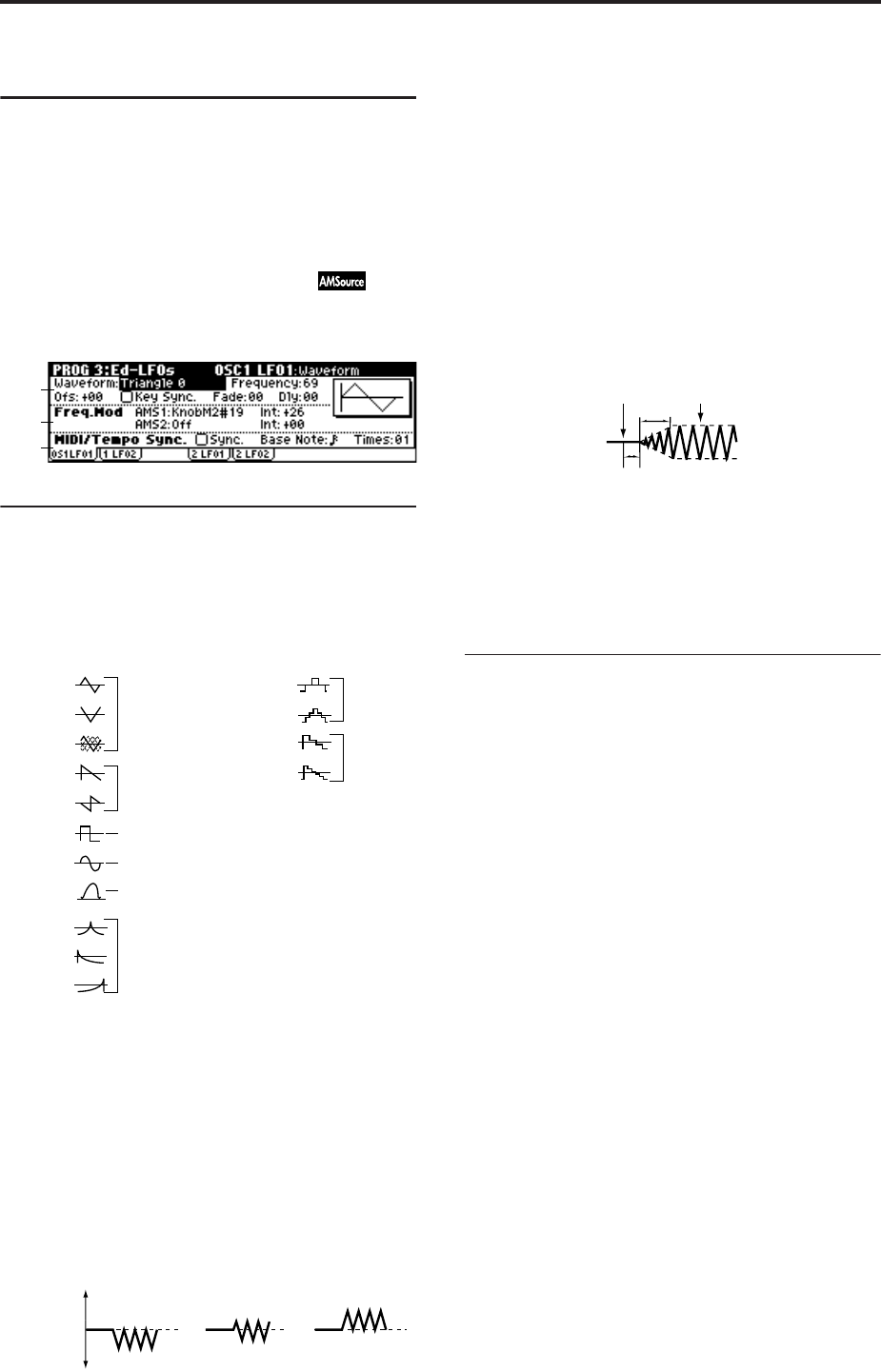
14
PROG 3: Ed–LFOs
Here you can make settings for the LFO that can be used to
cyclically modulate the Pitch, Filter, and Amp of oscillators 1
and 2. There are two LFO units for each oscillator.
By setting the LFO1 or LFO2 Intensity to a negative (–) value
for Pitch, Filter, or Amp, you can invert the LFO waveform.
3–1: OS1LFO1 (OSC1 LFO1)
Indicates settings for the “OSC1 LFO1,” which is the first
LFO that can be used for oscillator 1.
3–1a: OSC1 LFO1
Waveform [Triangle 0…Random6 (Vect.)]
Selects the LFO waveform.
The numbers that appear at the right of some of the LFO
waveforms indicate the phase at which the waveform will
begin.
Frequency [00…99]
Sets the LFO frequency. A setting of 99 is the fastest.
Ofs (Offset) [–99…+99]
Specifies the central value of the LFO waveform.
For example, with a setting of 0 as shown in the following
diagram, the vibrato that is applied will be centered on the
note-on pitch. With a setting of +99, the vibrato will only
raise the pitch above the note-on pitch, in the way in which
vibrato is applied on a guitar.
Offset settings and pitch change produced by vibrato
When “Waveform” is set to Guitar, the modulation will
occur only in the positive (+) direction even if you set “Off-
set” to 0.
Key Sync. [Off, On]
On (checked): Key Sync. will be On. The LFO will start each
time you play a note, and an independent LFO will operate
for each note.
Off (unchecked): Key Sync. will be Off, and the LFO effect
that was started by the first-played note will continue to be
applied to each newly-played note. (In this case, “Delay”
and “Fade” will be applied only to the LFO when it is first
started.)
Fade [00…99]
Specifies the time from when the LFO begins to apply until
it reaches the maximum amplitude.
When “Key Sync.” is Off, the fade will apply only when the
LFO is first started.
How “Fade” affects the LFO (when “Key Sync.” is On)
Dly (Delay) [00…99]
Specifies the time from note-on until the LFO effect begins to
apply.
When “Key Sync.” is Off, the delay will apply only when
the LFO is first started.
3–1b: Freq.Mod (Frequency Modulation)
You can use two alternate modulation sources to adjust the
speed of the OSC1 LFO1.
AMS1 (Freq. AMS1)
[Off, (PEG, FEG, AEG, LFO2, KT, EXT)]
Indicates the source that will adjust the frequency of the
oscillator 1 LFO1 (☞p.152 “AMS List”). OSC1 LFO1 can be
modulated by OSC1 LFO2.
Int (AMS1 Intensity) [–99…+99]
Specifies the depth and direction of the effect that “AMS1
(Freq. AMS1)” will have.
When this parameter is set to a value of 16, 33, 49, 66, 82, or
99, the LFO frequency being can be increased by a maxi-
mum of 2, 4, 8, 16, 32, or 64 times respectively (or decreased
by 1/2, 1/4, 1/8, 1/16, 1/32, or 1/64 respectively).
For example, if “AMS1 (Freq. AMS1)” is Note No., positive
(+) values of this parameter will cause the oscillator 1 LFO
to speed up as you play higher notes. Negative (–) values
will cause the oscillator 1 LFO to slow down as you play
higher notes. This change will be centered on the C4 note.
X50: If “AMS1 (Freq. AMS1)” is set to Mod.Whl#01, speci-
fying a higher value for this parameter will let you increase
the OSC1 LFO speed more greatly by moving the [MOD]
wheel. With a setting of +99, moving the [MOD] wheel all
the way up will increase the LFO speed by approximately 64
times.
microX: If “AMS1 (Freq. AMS1)” is set to JS +Y #01, rais-
ing the value of this parameter will cause the oscillator 1
LFO1 speed to increase as the joystick is moved up. With a
setting of +99, moving the joystick all the way up will
increase the LFO speed by approximately 64 times.
3–1a
3–1b
3–1c
Triangle wave
Phase will change
randomly at each key-in
Sawtooth down ↓
Square wave
Sine wave
Guitar vibrato
Triangle 0
Triangle 90
Triangle
Random
Saw 0
Saw 180
Square
Sine
Guitar
Exp.Triangle
Exp.Saw Down
Exp.Saw Up
Step Triangle – 4
Step Triangle – 6
Step Saw – 4
Step Saw – 6
Random1 (S/H):
Conventional sample & hold (S/H) in which the
level changes randomly at fixed intervals of
time
Random2 (S/H):
Both the levels and the time intervals will
change randomly.
Random3 (S/H):
The maximum level and minimum level will
alternate at random intervals of time (i.e., a
square wave with random period).
Random4 (Vect.)
Random5 (Vect.)
Random6 (Vect.)
These types cause Random 1–3 to change
smoothly. They can be used to simulate the
instability of acoustic instruments etc.
offset = –99 offset = 0 offset = +99Pitch
Pitch at note-on
Note-on Note-off
“Fade”
“Delay”


















